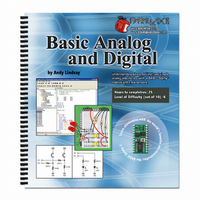28129 Parallax Inc, 28129 Datasheet - Page 39

28129
Manufacturer Part Number
28129
Description
TEXT BASIC ANALOG & DIGITAL
Manufacturer
Parallax Inc
Type
Programmingr
Datasheet
1.28129.pdf
(176 pages)
Specifications of 28129
Style
Book
Title
Basic Analog and Digital
Contents
Basic Analog and Digital Text
Product
Microcontroller Accessories
Lead Free Status / RoHS Status
Not applicable / Not applicable
- Current page: 39 of 176
- Download datasheet (3Mb)
Converting from binary to decimal takes two steps. The first step is to multiply each bit
by its power of two. Table 2-2 shows the powers of two for up to 8-bits. When you
multiply each bit by its value from Table 2-2, you end up with a series of decimal values.
The second step is to add up all the decimal values.
As an example, let’s convert binary-1011 to decimal. First, multiply each bit by its power
of two from Table 2-2.
Second, add all 4 of the decimal values:
Now we know the binary number 1011 is equal to the decimal number 11.
8 × 1 = 8
4 × 0 = 0
2 × 1 = 2
1 × 1 = 1
8 + 0 + 2 + 1 = 11
Bit multipliers and Powers of Two: Bit-0 is the least significant bit (LSB) and bit-7 is the
most significant bit (MSB). That’s because bit-0 makes the smallest contribution to the
number and bit-7 makes the largest contribution. Thinking about a binary number as starting
on the left with bit-7 and ending on the right with bit-0 is useful because these numbers
indicate the power of 2 for each digit.
Examples:
The multiplier for bit-0 is 1, which equals 2
The multiplier for bit-1 is 2, which equals 2
The multiplier for bit-7 is 128, which equals 2
Note: You can use powers of two to extend Table 2-2 to any number of bits!
Bit
Multiplier
Table 2-2: Bit Multipliers for an 8-bit Binary Number
128
7
64
6
32
5
0
1
.
.
7
.
16
4
3
8
2
4
1
2
0
1
Related parts for 28129
Image
Part Number
Description
Manufacturer
Datasheet
Request
R

Part Number:
Description:
Microcontroller Modules & Accessories DISCONTINUED BY PARALLAX
Manufacturer:
Parallax Inc

Part Number:
Description:
BOOK UNDERSTANDING SIGNALS
Manufacturer:
Parallax Inc
Datasheet:

Part Number:
Description:
COMPETITION RING FOR SUMOBOT
Manufacturer:
Parallax Inc
Datasheet:

Part Number:
Description:
TEXT INFRARED REMOTE FOR BOE-BOT
Manufacturer:
Parallax Inc
Datasheet:

Part Number:
Description:
BOARD EXPERIMENT+LCD NX-1000
Manufacturer:
Parallax Inc
Datasheet:

Part Number:
Description:
CONTROLLER 16SERVO MOTOR CONTROL
Manufacturer:
Parallax Inc
Datasheet:

Part Number:
Description:
BASIC STAMP LOGIC ANALYZER
Manufacturer:
Parallax Inc
Datasheet:

Part Number:
Description:
IC MCU 2K FLASH 50MHZ SO-18
Manufacturer:
Parallax Inc
Datasheet:














